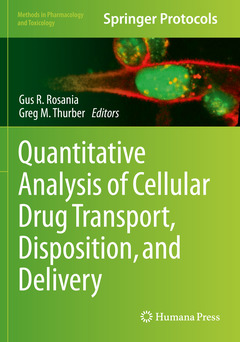Description
Quantitative Analysis of Cellular Drug Transport, Disposition, and Delivery, 1st ed. 2021
Methods in Pharmacology and Toxicology Series
Language: English
Subjects for Quantitative Analysis of Cellular Drug Transport...:
Publication date: 06-2021
453 p. · 17.8x25.4 cm · Paperback
Publication date: 06-2021
453 p. · 17.8x25.4 cm · Hardback
Description
/li>Contents
/li>Comment
/li>
Part I: Small Molecules
1. Measurement of Transcellular Transport Rates and Intracellular Drug Sequestration in the Presence of an Extracellular Concentration Gradient
Kyoung Ah Min and Gus R. Rosania
2. Kinetic Design for Establishing Long Term Stationary Cytosol Concentrations during Drug Transport across P-gp Expressing Confluent Cell Monolayers to Facilitate Measuring Cytosol Concentration, Fitting Drug Molar Partition Coefficients into the Cytosolic Monolayer of the Plasma Membrane and Kinetically Identifying Drug Uptake Transporters
Joe Bentz
3. In Vitro Methodologies to Assess Potential for Transporter-Mediated Drug-Drug Interactions
Jibin Li, Qing Wang, and Ismael J. Hidalgo
4. Determination of Fraction Unbound and Unbound Partition Coefficient to Estimate Intracellular Free Drug Concentration
Sangwoo Ryu, Keith Riccardi, Samantha Jordan, Nathaniel Johnson, and Li Di
5. Quantitative Analysis of Intracellular Drug Concentrations in Hepatocytes
Chitra Saran, James J. Beaudoin, Nathan D. Pfeifer, and Kim L.R. Brouwer
6. Quantification of Intracellular Drug Aggregates and Precipitates
Phillip Rzeczycki and Gus R. Rosania
7. Quantitative Phenotypic Analysis of Drug Sequestering Macrophage Subpopulations
Mikhail D. Murashov
8. Using an Integrated QSAR Model to Check Whether Small-Molecule Xenobiotics Will Accumulate in Biomembranes, with Particular Reference to Fluorescent Imaging Probes
Richard W. Horobin and Juan C. Stockert
9. Diversity-Oriented Fluorescence Library Approach (DOFLA) for Discovery of Cell-Permeable Probes for Applications in Live Cell Imaging
Dongdong Su and Young-Tae Chang
Part II: Macromolecules, Biologics, and Nanoparticles
10. Overcoming Cellular and Systemic Barriers to Design the Next Wave of Peptide Therapeutics
Jerome Hochman, Tomi Sawyer, and Ruchia Duggal
11. Intracellular Targeting of Cyclotides for Therapeutic Applications
Nicole Lawrence and David J. Craik
12. Cellular Trafficking of Monoclonal and Bispecific Antibodies
John J. Rhoden and Christopher M. Wiethoff
13. Quantitative Drug Target Imaging Using Paired-Agent Principles
Kenneth M. Tichauer, Negar Sadeghipour, Yu “Winston” Wang, Summer L. Gibbs, Jonathan T.C. Liu, and Kimberley S. Samkoe
14. Quantitative Determination of Intracellular Bond Cleavage
Joshua A. Walker, Michelle R. Sorkin, and Christopher A. Alabi
15. Development and Application of a Single Cell-Level PK-PD Model for ADCs
Shufang Liu and Dhaval K. Shah
16. Contribution of Non-Target Cells to the Disposition, Antitumor Activity, and Antigen-Independent Toxicity of Antibody Drug-Conjugates
David W. Meyer, Fu Li, and Robert P. Lyon
17. Tracking siRNA-Nanocarrier Assembly and Disassembly Using FRET
Lorenz Isert, Aditi Mehta, Friederike Adams, and Olivia M. Merkel
18. Sub-Cellular Drug Depots as Reservoirs for Small Molecule Drugs
Ran Li, Ralph Weissleder, and Miles A. Miller
Includes cutting-edge techniques
Provides step-by-step detail essential for reproducible results
Features information that applies to a wide array of research areas




